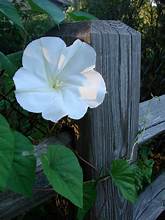How to Grow Moonflowers from Seeds: A Step-by-Step Guide
The scientific name for moonflowers is Ipomoea alba. They are unique plants with big heart-shaped leaves and trumpet-shaped flowers that open at night. People who prefer nighttime gardening adore them since they bloom and create a fragrance.
Moonflowers come in different varieties, including the perennial Ipomoea leptophylla, the pink Ipomoea muricata, and the white Ipomoea alba. Originally from the Americas, they are planted in gardens all around the world. Their delicate flowers contrast with the green foliage of the trees and plants they frequently grow around.

Moonflowers are symbolic of the spiritual journey from darkness to light and have cultural importance across the globe. Beyond their aesthetic value, they have useful functions as well. For example, their quick growth makes them excellent privacy screens, and they draw pollinators like moths, which help other plants that bloom at night to bloom.
Because these plants can develop quickly and spread quickly, it’s best to remove the seed pods on a regular basis to keep them under control.
Follow this step-by-step guide to cultivate moonflowers and turn your garden into a mystical retreat, from selecting the perfect sunny place to tending to the blossoms. Together, let’s go on this moon gardening journey!
Botanical Name: Ipomoea alba
Bloom Time: Late spring to early fall, with flowers opening in the evening and closing in the morning
Common Name: Moonflower, Moon Vine, Tropical White Morning Glory
Family: Convolvulaceae
Flower Color: White
Plant Type: Vine
Soil Type: Well-drained, fertile soil
Sun Exposure: Full sun to partial shade

Moonflower Care
Moonflower maintenance guarantees a colorful garden full of their alluring blossoms and alluring scent. They grow best on well-drained, fertile soil that has a pH of 6.0 to 7.5, as well as in full sun to partial shade. Moonflowers need slightly drier circumstances, so avoid overwatering them. They also act as support for climbing vines. Regular pruning aid in regulating growth and promote ongoing flowering.
During the growing season, feed your moonflowers every three to four weeks with a balanced, all-purpose fertilizer to increase vigor and flower production. Mulching the area around a plant’s base reduces weed development, controls soil temperature, and preserves moisture. To preserve the health of your plants, keep an eye out for pests like caterpillars and aphids and take quick action when necessary.
Watch the magic happen when their trumpet-shaped, fragrant, huge flowers open in the evening, luring pollinators who fly by night with their lovely aroma. Your garden will become an enthralling moonlit paradise with the right care and attention given to your moonflowers.
1. Soil
Select well-drained soil with a pH of neutral to slightly acidic for healthy moonflower growth. Add organic matter, such as manure or compost, to the soil to improve fertility and supply necessary nutrients. Mulching around the base helps to provide the ideal conditions for bright flowers by preserving moisture and shielding roots from intense heat. Your garden will be captivated with your moonflowers if the soil is correct.
2. Light
Although they can survive both shade and direct sunlight, moonflowers need at least six hours of direct sunlight per day to grow. Sufficient sunshine promotes dense development and intensifies the nighttime scent and colour of their blossoms. Additionally, it aids in leaf drying, warding off typical problems like bugs and illnesses. Whether planted in shady garden nooks or along sunny fences, moonflowers thrive best when the light is just right.
3. Water
For moonflowers to develop healthily and to avoid overwatering or underwatering, proper watering is essential. Especially during the warmer months, keep the soil continuously moist but not soggy during active growth. Because they are drought-sensitive, moonflowers need to be watered sparingly to keep an even moisture level during dry times. As water needs reduce in the cooler months, adjust the frequency of watering. Mulching the area around the base helps control soil temperature, hold onto moisture, and require less watering.
4. Humidity and Temperature
Moonflowers are temperature-tolerant plants that grow best in full light in zones 10–12 and exhibit resilience in zones 8 and 9. Even though they like high humidity, well-watered plants can withstand dry air. Sufficient irrigation, particularly in arid periods, guarantees that these blossoms stay hydrated. Plants are shielded from severe weather by mulching, which holds moisture and insulates them from temperature changes. In tropical heat or cooler temperatures, plentiful flowers are produced with consistent hydration and care.
5. Fertilizers
Use a slow-releasing, balanced fertilizer early in the spring to encourage vigorous blossoming during the moonflowers’ growth phase. Keep the organic mulch around the base in place to supply micronutrients and retain soil moisture. On the other hand, stay away from overfertilizing, since this might result in pest infestation, leaf spot, and powdery mildew. Fertilizing moonflowers requires patience and close observation.
6. Pruning
By eliminating damaged or dead branches and encouraging vigorous development, early spring pruning of moonflowers improves their appearance and growth. To keep the plant in its natural form and avoid stress, don’t prune it too much. Maintaining the garden’s order and preventing infections after trimming is essential for the general health of the vines.
7. Overwintering
It’s critical to take precautions in order to keep moonflowers healthy and vigorous throughout the winter. By adding a layer of mulch around the plant’s base, you can protect the roots from freezing conditions by retaining moisture and warmth. Well-drained soil is essential to preventing root rot, even in the winter. When springtime finally arrives, these steps guarantee a flourishing moonflower display.
How to grow Moonflower from seeds?
This comprehensive guide will teach you how to plant moonflowers from seeds, providing you with personalized guidance and useful suggestions for growing these charming blossoms in your yard. Moonflowers beneath a moonlit sky are a mesmerising sight, and they can be added to your garden with patience and the right skills.
1.Seed preparation
Moonflower seeds should be prepared by soaking them for a whole night to soften their hard coat. In your garden, pick a sunny place and make sure the soil is well-draining and neutral to slightly acidic.
2. Planting the seeds
Plant the soaked moonflower seeds 1 inch deep in prepared soil, spacing them 6-12 inches apart. Cover lightly with soil and gently pat the surface.
3. Providing the right conditions
Moonflowers require continually moist soil and do well in warm weather. In order to keep moisture in the soil, prevent weed growth, and control soil temperature, mulch should be applied around the base of seeds and seedlings.
4. Addressing common pests and problems
Keep an eye out for pests such as slugs, aphids, and snails on moonflowers and use natural repellents or soapy water to control infestations. Watch for yellowing leaves and make sure the drainage is adequate to prevent root rot to prevent overwatering.
5. Flowering and aftercare
Moonflowers can bloom profusely from late spring to early autumn and release their aroma in the twilight with the right care. To preserve plant beauty and encourage continued flowering, deadhead spent blooms and fertilizer occasionally.
Conclusion
You may successfully grow moonflowers from seeds by following these instructions, and you can enjoy their charming, fragrant blossoms all season long. These stunning nocturnal flowers can adorn your landscape and create a mystical ambiance under the moonlight with the right planning, planting, watering, and maintenance.



Pingback: lily flowers, Growing Lilies, How to plant and care, varieties
I am genuinely thankful to the owner of this website for sharing his brilliant ideas. I can see how much you’ve helped everybody who comes across your page. By the way, here is my webpage UQ5 about Thai-Massage.
Přijetí hypoteční platby může být nebezpečný pokud nemáte rádi čekání
v dlouhých řadách , vyplnění mimořádné formuláře ,
a odmítnutí úvěru na základě vašeho úvěrového
skóre . Přijímání hypoteční platby může být problematické, pokud
nemáte rádi čekání v dlouhých řadách , podávání extrémních formulářů , a
odmítnutí úvěru na základě vašeho úvěrového skóre .
Přijímání hypoteční platby může být problematické , pokud
nemáte rádi čekání v dlouhých řadách , vyplnění
extrémních formulářů a odmítnutí úvěrových rozhodnutí založených na úvěrových skóre .
Nyní můžete svou hypotéku zaplatit rychle a efektivně v České
republice. https://groups.google.com/g/sheasjkdcdjksaksda/c/sFLL7Q2TM40
Přijetí hypoteční platby může být nebezpečný pokud nemáte rádi čekání v dlouhých řadách , vyplnění mimořádné formuláře ,
a odmítnutí úvěru na základě vašeho úvěrového
skóre . Přijímání hypoteční platby může být problematické, pokud nemáte
rádi čekání v dlouhých řadách , podávání extrémních formulářů ,
a odmítnutí úvěru na základě vašeho úvěrového skóre .
Přijímání hypoteční platby může být problematické , pokud nemáte rádi čekání v dlouhých řadách
, vyplnění extrémních formulářů a odmítnutí úvěrových rozhodnutí založených na úvěrových skóre .
Nyní můžete svou hypotéku zaplatit rychle a efektivně v České republice. https://groups.google.com/g/sheasjkdcdjksaksda/c/sFLL7Q2TM40
Do you mind if I quote a few of your posts
as long as I provide credit and sources back to your site?
My website is in the vvery same niche as yous and my visitors
would really benefit from some of the information you
provide here. Please lett me know if this okay with you. Thank
you! https://evolution.org.ua/
Okay sure! You can quote it.